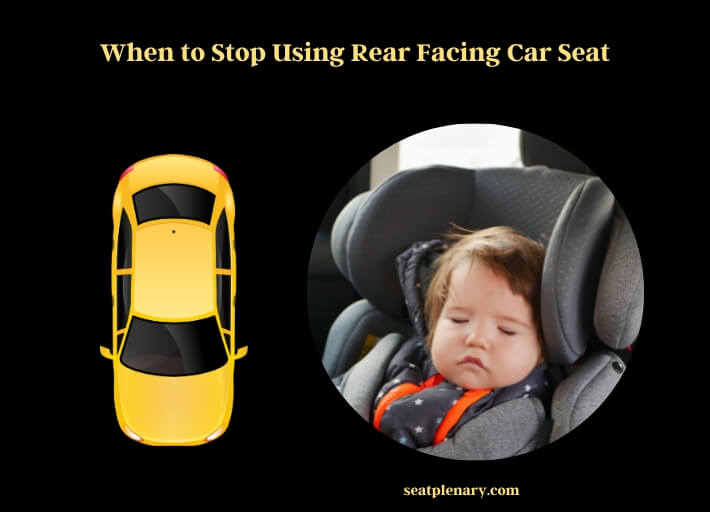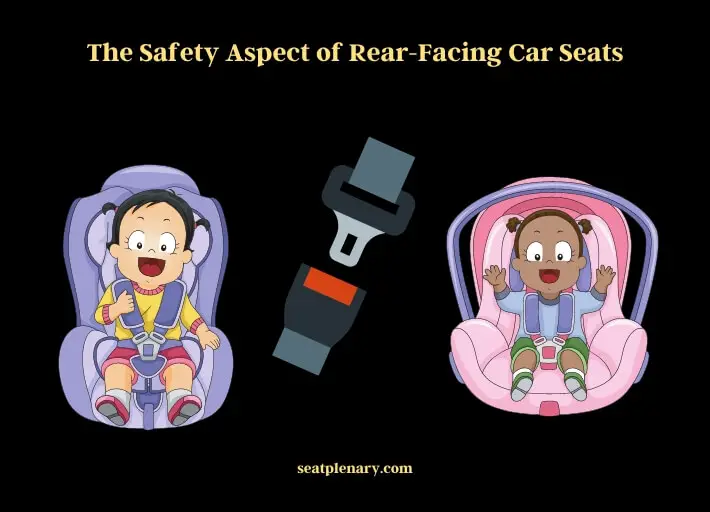As a parent, there’s no topic that grabs your attention faster than the safety of your little ones, especially when it comes to car safety. The question – when to stop using rear facing car seat, becomes crucial as your baby grows. Aiming to provide a comprehensive understanding of this subject, this article outlines the various factors that influence your decision.

When to Stop Using Rear Facing Car Seat
When it comes to transitioning your child from a rear-facing car seat to a forward-facing one, numerous factors come into play, such as your child’s age, weight, height, and overall development.
Age Considerations
As a rule of thumb, the American Academy of Pediatrics (AAP) advises parents to keep their children in rear-facing car seats until they are at least two years old. However, the ultimate determinant should not be age alone but a combination of the other factors we will discuss further.
Weight and Height Guidelines
Most rear-facing car seats accommodate children up to 40 pounds, although some models are suitable for kids up to 50 pounds. It’s crucial to check the weight and height specifications of your particular car seat model.
The Importance of Developmental Milestones
While guidelines are important, you also need to gauge your child’s readiness for the transition based on their physical development and comfort level.
The Safety Aspect of Rear-Facing Car Seats
The safety of our children is paramount, especially during vehicle transit. It’s important to understand why rear-facing car seats are preferred for infants and toddlers.
Impact Distribution
One of the main advantages of a rear-facing car seat lies in how it deals with the forces generated in a crash. During a frontal collision, which is the most common type of car accident, a rear-facing car seat evenly distributes the crash forces over the child’s entire body. The sturdy shell of the car seat absorbs most of the impact, significantly reducing the stress on any single part of the child’s body.
Protection of the Head and Neck
Infants and young toddlers have relatively large heads and weak neck muscles. In a collision, the head can jerk forward abruptly, causing severe neck injuries.
A rear-facing car seat is designed to fully support the child’s head, neck, and spine. The car seat acts as a cushion, preventing the child’s head from snapping forward in a crash.

Securing the Child’s Body
In a rear-facing car seat, the harness straps go over the child’s shoulder and between their legs, securing the child at their strongest points. This ensures that the child stays in the seat and reduces the risk of ejection during an accident.
Minimizing Intrusion Risk
Rear-facing car seats are also beneficial in the event of a side or rear impact. The car seat’s shell provides a protective barrier between the child and any intruding objects or debris.
The Process of Transitioning to a Forward-Facing Seat
Shifting from a rear-facing to a forward-facing car seat is a milestone in your child’s life. It’s not just about turning the seat around, but it also requires understanding the new mechanics and ensuring your child is ready for the change.
Installing the Forward-Facing Car Seat
Proper installation of a car seat is critical. While installing a forward-facing seat, ensure that the car’s seat belt or lower anchors securely fasten the car seat. The tether should be firmly attached to the tether anchor, and the seat should not move more than an inch side-to-side or front-to-back. Each car seat model has its specific installation instructions, so refer to the manual to guarantee a secure fit.
Understanding the Seat Mechanisms
Unlike rear-facing car seats, forward-facing car seats come equipped with a tether strap. This strap prevents the seat from pitching forward in a crash, offering additional protection. Parents must familiarize themselves with this and other new mechanisms like the chest clip and buckle positions to ensure they can properly harness their child in the seat.
Ensuring Your Child’s Comfort
Your child should be comfortable with the transition. Initially, they might resist the change as the world suddenly appears in reverse to them. Start with short trips and gradually increase the duration to help your child adjust to the new orientation. Look out for signs of discomfort such as motion sickness or fear, and address them promptly to ensure a smooth transition.
Educating Your Child
As your child grows, they start to learn and understand the importance of safety measures. Explain to your child why they must sit in a car seat and the significance of the safety harness. Engaging them in the process will make them more accepting of the change.
Expert Opinions on Rear-Facing Car Seats
Deciding when to transition from a rear-facing car seat to a forward-facing one can be a daunting task for parents. To help navigate this tricky period, let’s hear what safety experts and pediatricians have to say.
Views from The American Academy of Pediatrics
The American Academy of Pediatrics (AAP) is a trusted source of advice for many parents. Their stance on this matter is clear: children should remain in rear-facing car seats for as long as possible. Specifically, they recommend that children continue to use a rear-facing car seat until they reach the maximum height or weight limit stated by the car seat manufacturer. This can often mean children above two years old will still be rear-facing, which offers optimal protection in the event of a crash.
Pediatricians’ Advice
In alignment with the AAP, pediatricians emphasize the safety benefits of rear-facing car seats. They point to the physiological facts: a child’s neck and spine are not fully developed until they’re older, and a rear-facing car seat offers the best support in these areas during the critical developmental stage. So, beyond just the numbers, pediatricians encourage parents to consider their child’s physical development and readiness for the transition.
Insights from Child Passenger Safety Technicians
Child Passenger Safety Technicians (CPSTs) are professionals trained to assist parents in correctly installing car seats and securing children. Their opinion? The longer a child can stay rear-facing, the better. Like the AAP, they advocate that parents adhere to the car seat manufacturer’s weight and height limits before transitioning to a forward-facing seat.
Finally you can see the video [Length of time to keep children in rear-facing car seats] from ‘FOX 7 Austin’ channel:
Frequently Asked Questions (FAQs)
When to stop using rear facing car seat according to weight?
Each car seat model has different weight limits. Typically, you can stop using a rear-facing car seat when your child exceeds the maximum weight limit specified by the car seat manufacturer. This is often between 40-50 pounds.
Can I transition my one-year-old child to a forward-facing car seat?
Although it’s technically legal to switch at one year in some states, it’s highly recommended to keep your child in a rear-facing car seat until they’re at least two years old for maximum safety.
Are there any car seats that can accommodate heavier kids in the rear-facing position?
Yes, there are car seats designed to accommodate larger kids. These are often convertible car seats that can be used as both rear-facing and forward-facing.
What if my child’s legs touch the back of the vehicle seat?
As long as your child is within the weight and height limits of the car seat and isn’t complaining about discomfort, it’s fine if their legs touch the back of the vehicle seat.
How do I know if my child is comfortable in a rear-facing car seat?
Your child will likely express discomfort by being fussy during car rides. Also, check for signs of cramped legs or poor posture.
Can I use a rear-facing car seat in the front seat of the car?
No, rear-facing car seats should always be installed in the back seat of the car. The front passenger airbag can seriously injure a child in a crash if it’s deployed.
Conclusion
In the journey of parenthood, deciding when to stop using a rear-facing car seat is a significant milestone. It’s a decision that should not be taken lightly, considering its direct impact on your child’s safety during transit.
From expert advice to safety considerations, the consistent message is that the rear-facing position is safer for young children. Be sure to keep your child in a rear-facing car seat until they reach the maximum weight or height limit set by the car seat manufacturer. This may mean surpassing their second birthday or even their third in some cases.
These guidelines aren’t rigid rules but should be used in combination with your judgment as a parent. No one knows your child better than you do. Consider their comfort, size, and overall developmental readiness as you decide on this transition.
In conclusion, while it’s exciting to watch your child grow and transition into new stages, when it comes to car seat orientation, the “rear view” is the safest option for the youngest passengers. Don’t rush the process, let safety, comfort, and developmental readiness be your guiding stars.
Remember, each day, each car ride is about creating memories and bonding moments with your child. Making safety a priority ensures many more opportunities for such priceless experiences. Safe travels!
Read More:
